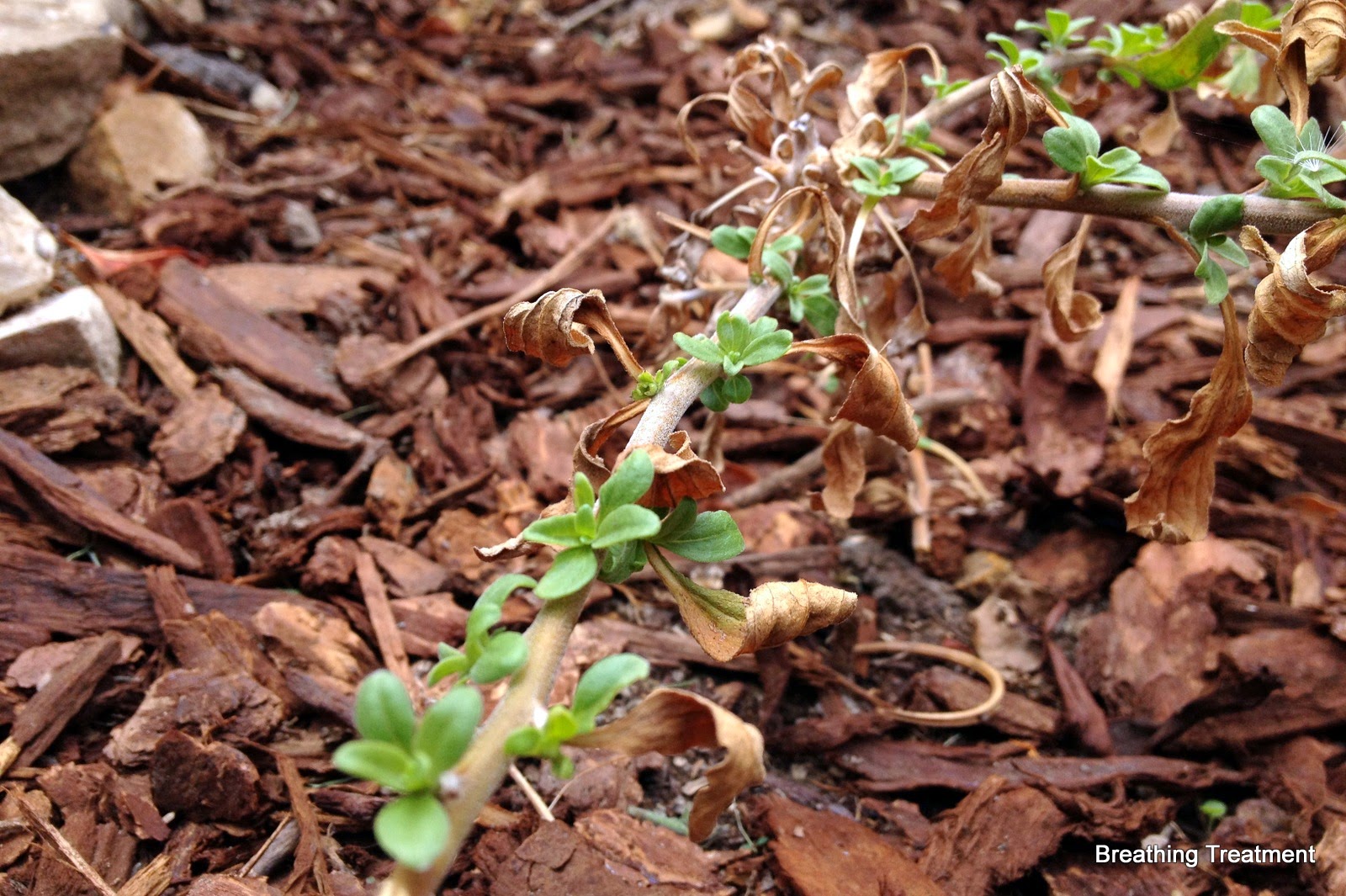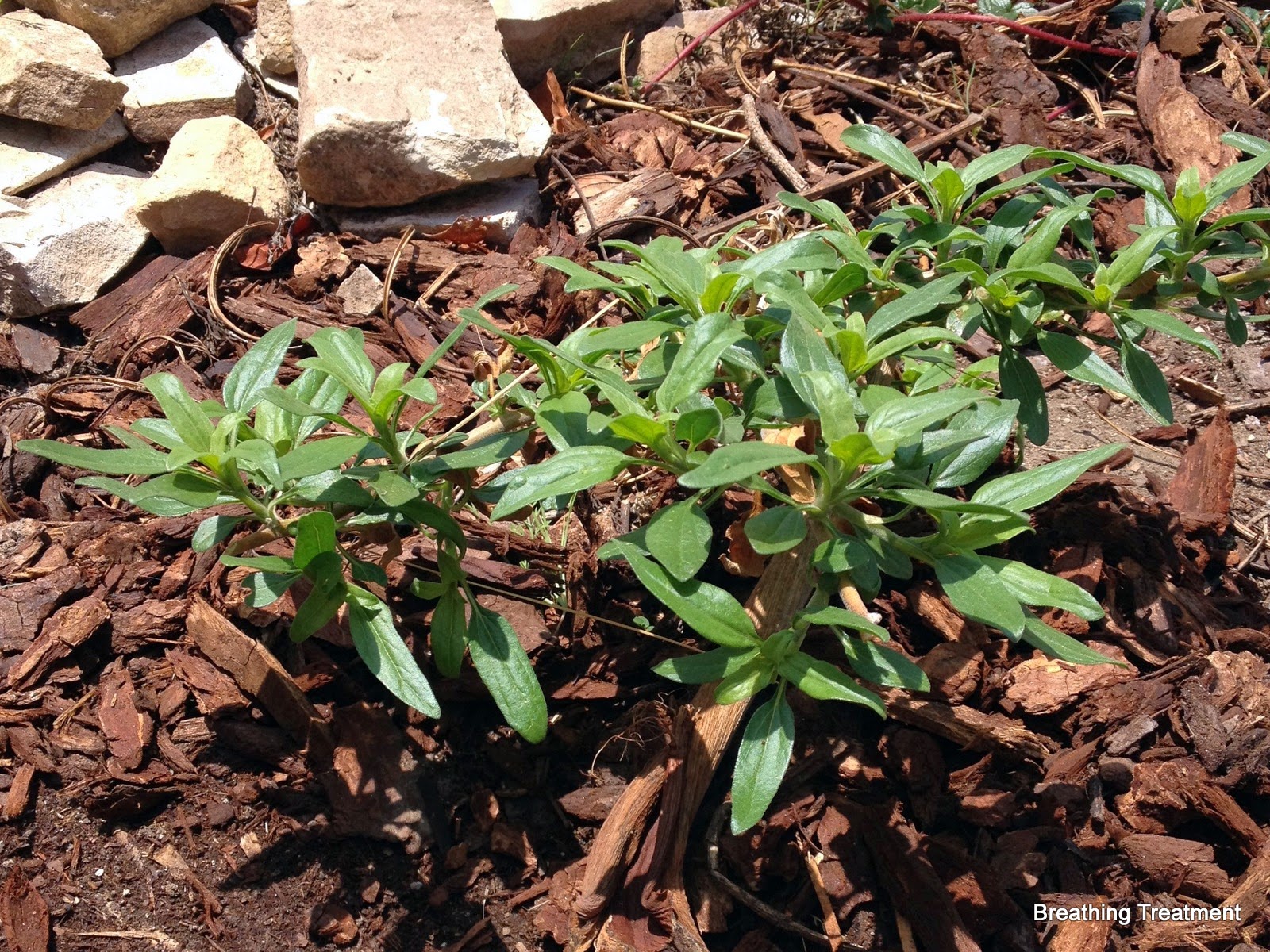2014-06-21
Red Buckwheat
This is the first year of bloom for Eriogonum grande var. rubescens (Red Buckwheat) in my garden. This photo was taken June 4 and shows the one plant that has spent a year in the garden. However, others that I installed in fall are also blooming to a lesser degree.
2014-06-20
Iris funk
Earlier this year I decided to install some Iris 'Dark Clouds'adjacent to my 1 year old Iris 'Canyon Snow'. My experience is that Iris are hard to initially transplant and establish, but once they have taken hold in the garden they are robust. Additionally, Iris can look ratty after they bloom, but it's been my experience that if they have any strong and healthy growth, that they will survive and come back the following year.
One of my more established 'Canyon Snow' had about a 50% die back, but I wasn't too upset, since the remaining growth was strong.
However, two of three newly installed Iris 'Dark Clouds' had a significant amount of die back with little corresponding strong growth. I'll continue to baby them, but they may be goners.
One of my more established 'Canyon Snow' had about a 50% die back, but I wasn't too upset, since the remaining growth was strong.
However, two of three newly installed Iris 'Dark Clouds' had a significant amount of die back with little corresponding strong growth. I'll continue to baby them, but they may be goners.
2014-06-18
Mesembryanthemum crystallinum (common iceplant, crystalline ice plant) at Portuguese Bend
Mesembryanthemum crystallinum (common iceplant, crystalline ice plant) found adjacent to the road in at Portuguese Bend. I had thought since I first observed it that this was a native, due to the tenacious way that it clung to seaside crevices and novel appearance of dew drops on its leaves. I was wrong. It's actually an invasive plant. Wikipedia has useful information.
The plant usually uses C3 carbon fixation, but when it becomes water- or salt-stressed, it is able to switch to Crassulacean acid metabolism. Like many salt-tolerant plants, M. crystallinum accumulates salt throughout its life, in a gradient from the roots to the shoots, with the highest concentration stored in epidermal bladder cells. The salt is released by leaching once the plant dies. This results in a detrimental osmotic environment preventing the growth of other, non-salt-tolerant species while allowing M. crystallinum seeds to germinate.
2014-06-16
Saltbush (Atriplex Brewerii) galls at Portugese Bend
Atriplex lentiformis Breweri (also Salt Bush, Quail Bush, and formerly Atriplex Breweri) grows abundantly on the Palos Verdes peninsula. Out on a hike the other day I noticed what appeared to be galls on it:
2014-06-12
Garrya pruned
I asked in my previous blog whether I ought to prune my new Garrya elliptica 'Evie'.
I did and here's what it looks like.
Time will tell whether this was good choice or not. I sort of think that it was, based on the principle that pruning early in life sets longer term growth patterns, and given that this is a potted plant, I need to keep it a somewhat compact.
I Googled some interesting commentary from the California Native Plant Society about this genus. G. elliptica is not actually native to LA County; it is naturally found in Ventura county north. Perhaps a better choice for my leeward side of Palos Verdes in the generally more arid Los Angeles county would have been as indicated in this except from the CNPS web page on Garrya.
In Southern California, G. elliptica likes extra watering, but it also needs well-drained soil. Plants grown in insufficient drainage can be prone to water molds. The species in general is also susceptible to Botryosphaeria, a fungal disease that can result in branch dieback. Pruning in summer months and with proper hygienic practices will help deter the spread of this pathogen.
If you are not on the coast, seek out the species of silk tassel bush like G. fremontii or G. flavescens that grow in inland areas. G. flavescens is native to chaparral areas in Southern California, and lights up like a Christmas tree when in bloom. These species can be much more difficult to find than the more readily available G. elliptica, but your search may be rewarded with an unusual specimen of beautiful native shrub.
I did and here's what it looks like.
Time will tell whether this was good choice or not. I sort of think that it was, based on the principle that pruning early in life sets longer term growth patterns, and given that this is a potted plant, I need to keep it a somewhat compact.
I Googled some interesting commentary from the California Native Plant Society about this genus. G. elliptica is not actually native to LA County; it is naturally found in Ventura county north. Perhaps a better choice for my leeward side of Palos Verdes in the generally more arid Los Angeles county would have been as indicated in this except from the CNPS web page on Garrya.
In Southern California, G. elliptica likes extra watering, but it also needs well-drained soil. Plants grown in insufficient drainage can be prone to water molds. The species in general is also susceptible to Botryosphaeria, a fungal disease that can result in branch dieback. Pruning in summer months and with proper hygienic practices will help deter the spread of this pathogen.
If you are not on the coast, seek out the species of silk tassel bush like G. fremontii or G. flavescens that grow in inland areas. G. flavescens is native to chaparral areas in Southern California, and lights up like a Christmas tree when in bloom. These species can be much more difficult to find than the more readily available G. elliptica, but your search may be rewarded with an unusual specimen of beautiful native shrub.
2014-06-10
The garden in May and a 100+ year glimpse of history
Photos of selected plants in the garden on 5/28/2014 and commentary.
The Ribes aureum var. gracillimum (Golden Currant) had a brief bloom and then headed straight to ripe fruit. These taste good. I'm surprised the birds and other critters haven't discovered them.
The Ribes aureum var. gracillimum (Golden Currant) had a brief bloom and then headed straight to ripe fruit. These taste good. I'm surprised the birds and other critters haven't discovered them.
2014-06-07
Remember that hot spell we had?
Remember the small native plant garden that I installed in the neighbor's yard at the San Pedro Annex? It's shown below after install on Sunday 5/18.
I had the misfortune of installing it right before a series of unprecedented hot days and the plants suffered for it. I thought that I would be replacing many plants, but it turned out that at least the Encelia (Brittlebush, goldenhills, incienso) have made a recovery. I think it helped that I clipped the branches back about 1/3rd, though not soon enough to prevent loss of nearly all their leaves.
The recovery was first evident to me on 5/24 with the releafing shown below:
By 6/1 recovery was in full swing:
6/8 even more growth:
I wasn't so fortunate with the strawberries (Fragaria) and was forced to replace all but one. Still, I felt fortunate and I'm surprised by the strong recovery of the Encelia.
I had the misfortune of installing it right before a series of unprecedented hot days and the plants suffered for it. I thought that I would be replacing many plants, but it turned out that at least the Encelia (Brittlebush, goldenhills, incienso) have made a recovery. I think it helped that I clipped the branches back about 1/3rd, though not soon enough to prevent loss of nearly all their leaves.
The recovery was first evident to me on 5/24 with the releafing shown below:
By 6/1 recovery was in full swing:
6/8 even more growth:
I wasn't so fortunate with the strawberries (Fragaria) and was forced to replace all but one. Still, I felt fortunate and I'm surprised by the strong recovery of the Encelia.
2014-06-04
Heat island miniatures
It's about time for another in my irregular feature, Don't Do This.
Let's start with a close up of 2011's and 2012's trendy plant, a succulent. This one looks like a Dudleya. So far so good.
Now pan to the full expanse of yard and to see the full glory...
Let's start with a close up of 2011's and 2012's trendy plant, a succulent. This one looks like a Dudleya. So far so good.
Now pan to the full expanse of yard and to see the full glory...
2014-06-02
Rain catcher design proves too costly
I'm looking at arbor / pergola and trellis designs that I like and collecting them over on Pinterest.
Follow Brent's board Arbors and Trellises on Pinterest.
This one from Lowes caught my eye because it is simple and has a number of design elements that I might like to consider. It also has a bill of materials and costs for each part of the construction. Overall, this is just the sort of useful garden construction advice that I like to see online. Bravo to Lowes.
However, one of the design features of the arbor is a "rain catcher" which is a section of 6" PVC pipe stood on end and fed by a downspout. Go to the article linked above to see the construction details or just take my word for it. The BOM is reproduced below showing a total price of $125!!
Follow Brent's board Arbors and Trellises on Pinterest.
This one from Lowes caught my eye because it is simple and has a number of design elements that I might like to consider. It also has a bill of materials and costs for each part of the construction. Overall, this is just the sort of useful garden construction advice that I like to see online. Bravo to Lowes.
However, one of the design features of the arbor is a "rain catcher" which is a section of 6" PVC pipe stood on end and fed by a downspout. Go to the article linked above to see the construction details or just take my word for it. The BOM is reproduced below showing a total price of $125!!
Subscribe to:
Posts (Atom)










